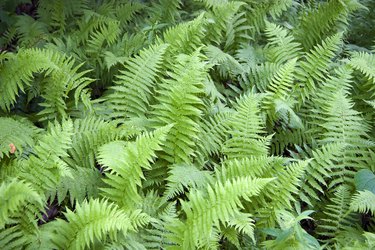
Ferns stand out among garden regulars for their lack of flowers and seeds. Botanically, they belong to the division of non-flowering plants known as Pteridophyta. With more than 10,000 known species of modern ferns, these plants display tremendous diversity in size, form and cultural needs. Even so, some general structural and reproductive characteristics of ferns distinguish them from all other plants.
Ferns Have Stemlike Rhizomes
Video of the Day
Instead of the stems common to most plants, one of the characteristics of ferns is that they have rhizomes, advises the University of Kentucky. Usually growing underground or right along the surface, these horizontal stems hold the vascular system that transports water and nutrients. Fern leaves spring up from the upper side of rhizomes while roots grow on the underside.
Video of the Day
Clump-forming ferns have a crownlike rhizome, and other types spread. Ostrich fern (Matteuccia struthiopteris), for example, hardy in U.S. Department of Agriculture plant hardiness zones 3 through 7, colonizes eagerly as its running rhizomes sprout leaves along their length. Tree ferns' rhizomes grow erect. The trunklike, 28-inch-diameter rhizome of soft tree fern (Dicksonia antarctica, USDA zones 9 through 10) takes the plant to a height up to 30 feet.
Leafy Fronds on Ferns
A fern frond begins at the rhizome and ends at the leaf tip. The base stalk, called a stipe, holds the leafy portion known as the blade. Fern leaves can be whole, such as the straplike leaves of bird's nest fern (Asplenium nidus, USDA zones 11 through 12). They can also be divided and subdivided into complex leaf forms, right down to 1/16-inch fronds of aquatic ferns. Many fern fronds unfurl in a classic fiddlehead shape known as a crozier.
Some types of fern plants have edible fronds; some do not. Small hairs and scales on some fronds reflect light and create colorful foliage. The fronds of Christmas fern (Polystichum acrostichoides, USDA zones 3 through 9) remain evergreen.
Spores and Sporangia
Rather than seeds, ferns produce tiny spores, advises the Brooklyn Botanic Garden. The spore-producing capsules, known as sporangia, form in clusters called sori. Often mistaken for scale insects, sori appear in distinctive shapes, patterns and places that identify different fern species. In some types of fern plants, a leaf section rolls over and protects the sori. Other species have protective, disclike flaps called indusia.
Kidney-shaped indusia cover the round sori of autumn fern (Dryopteris erythrosora, USDA zones 5 through 8) and mature in colorful stages from pink to red. When the time is right, fern sporangia catapult their spores onto the wind. A single fern produces multitudes of spores in a lifetime, but few survive.
Reproductive Characteristics of Ferns
Spores are just the first step in fern reproduction. The spores that find hospitable conditions form simple, heart-shaped, 1/2-inch-wide plants called prothallia, which lie on the soil. These inconspicuous plants form male and female organs. If moisture is present, fertilization can occur, and new ferns eventually result. Some desert ferns can reproduce without water or fertilization, but most ferns demand moisture.
Characteristic habitats for survival and reproduction are moist, humid, shaded areas that retain dampness year-round. Few ferns tolerate direct sunlight, low humidity, boggy conditions or deep shade. Evergreen species tolerate the lowest light levels. The more sun exposure, the more water ferns require.